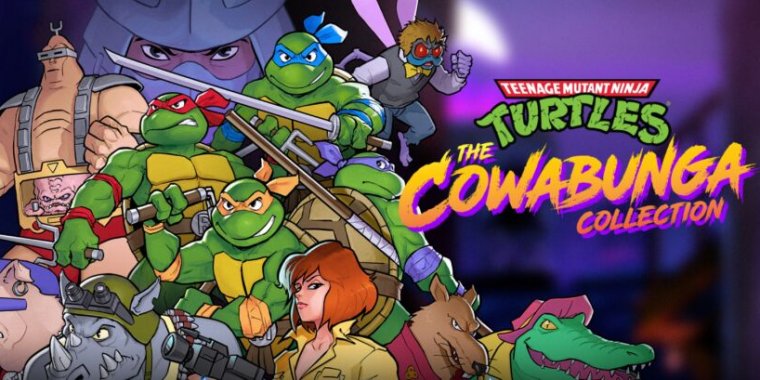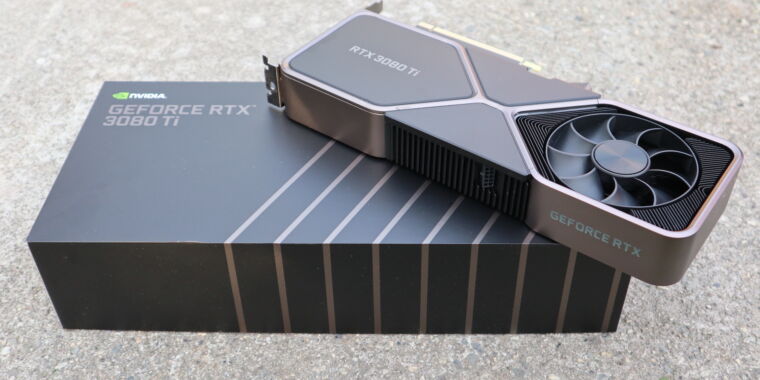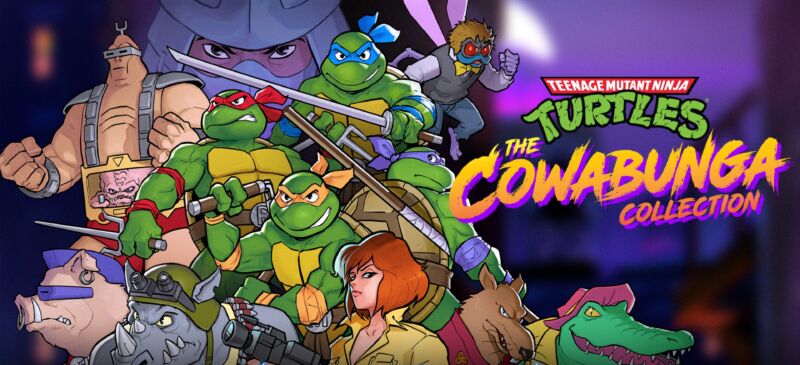
Konami / Nickelodeon / Digital Eclipse
In any other year, Teenage Mutant Ninja Turtles: The Cowabunga Collection would be a no-brainer recommendation for ’90s gaming nostalgia. Who could turn down an invite to an arcade stocked with 13 of the series’ earliest hit games, all set up for free play with welcome modern tweaks?
But this far into 2022, another arcade filled with Turtles fun has already opened on the same block. Shredder’s Revenge, a new title featuring the series’ old-school arcade action, earned a spot in our year-end best-of list barely two months ago—and its brilliant, beautiful, six-player fun costs $15 less.
TMNT fanatics with big gaming budgets can look forward to a competent and content-rich Cowabunga compilation, and we generally recommend the new collection to that crowd, despite some issues. But for fans with more limited time and money, Shredder’s Revenge is the better ’90s-styled arcade brawler by far—and it shows that The Cowabunga Collection‘s games have aged somewhat poorly.
A lot of games in only five years
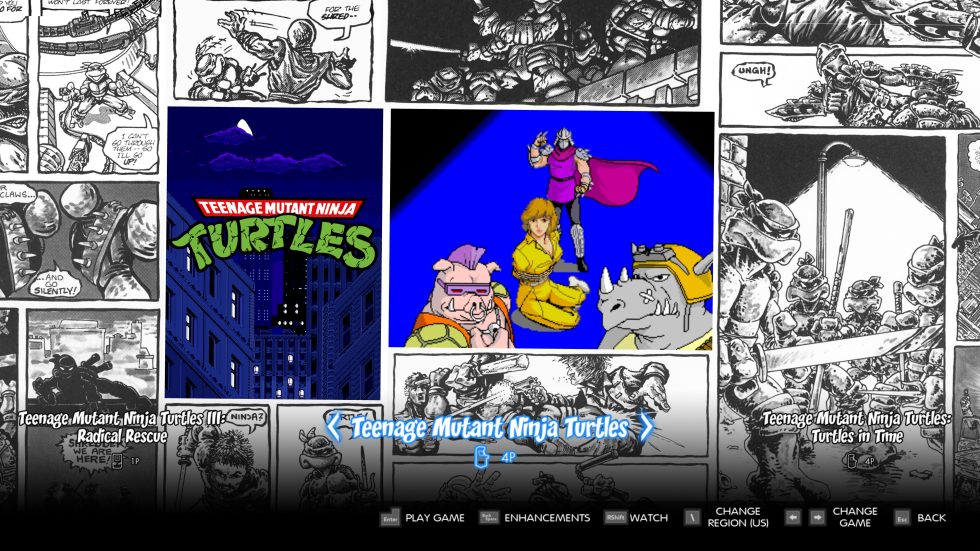
Konami / Nickelodeon / Digital Eclipse
The best part of TMNT:CC is its treasure trove of games, which have somehow been approved by a slew of different license holders to land in the same compilation for a reasonable price. In addition to its pair of memorable arcade cabinets, which have never received a direct retail port to home consoles, TMNT:CC also gathers every series entry from the NES, Super NES, Game Boy, and Sega Genesis. That list, for anyone who has lost track, includes:
• Teenage Mutant Ninja Turtles* (Arcade), 1989
• Teenage Mutant Ninja Turtles: Turtles in Time* (Arcade), 1991
• Teenage Mutant Ninja Turtles (NES), 1989
• Teenage Mutant Ninja Turtles II: The Arcade Game (NES), 1990
• Teenage Mutant Ninja Turtles III: The Manhattan Project (NES), 1991
• Teenage Mutant Ninja Turtles: Tournament Fighters (NES), 1994
• Teenage Mutant Ninja Turtles IV: Turtles in Time (SNES), 1992
• Teenage Mutant Ninja Turtles: Tournament Fighters* (SNES), 1993
• Teenage Mutant Ninja Turtles: The Hyperstone Heist* (Sega Genesis), 1992
• Teenage Mutant Ninja Turtles: Tournament Fighters (Sega Genesis), 1993
• Teenage Mutant Ninja Turtles: Fall of The Foot Clan (Game Boy), 1990
• Teenage Mutant Ninja Turtles II: Back From The Sewers (Game Boy), 1991
• Teenage Mutant Ninja Turtles III: Radical Rescue (Game Boy), 1993
Games with an asterisk include online support in the launch version of this compilation.
There’s no universe where retro fanatics can gather physical copies of these 13 games (which would include two arcade motherboards) for just $40, let alone their region-specific variants. We champion compilations like these, which give classic-gaming fans a legitimate path toward buying and enjoying old favorites. What’s more, the collection’s stewards at Digital Eclipse do an admirable job ensuring that the games play well on modern hardware.
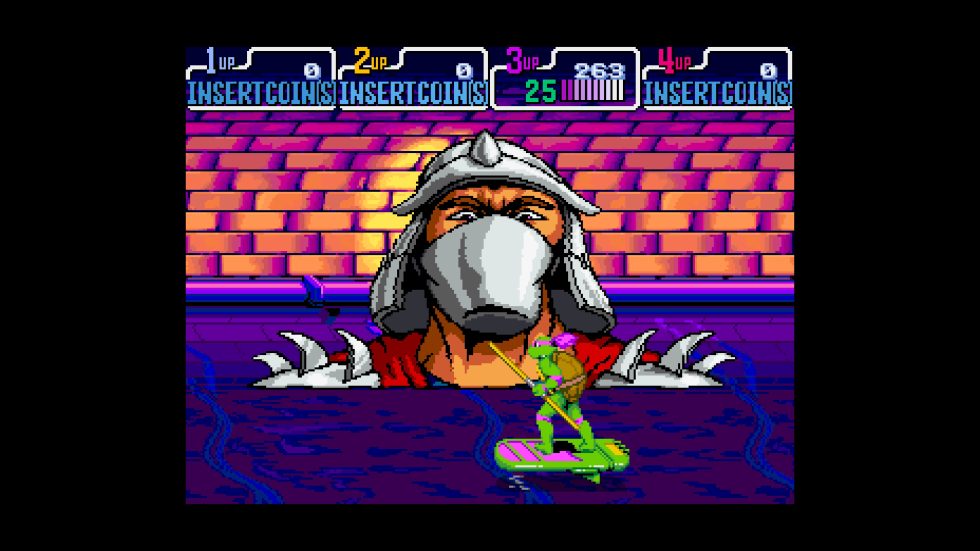
The best thing I can say is that each game nails the basics: solid emulation for every platform, from the lowly Game Boy all the way to Konami’s custom arcade hardware. Button-tap latency is kept to a tolerable minimum, while color reproduction and frame rates match original hardware for the most part, and frame interpolation is implemented quite well to reduce pixel shimmer while your favorite turtle teens run from left to right. Digital Eclipse’s NES and Game Boy emulators are kind to their source material and don’t fully replicate those systems’ heinous sprite flicker (though some of it is still left in for purists). Even so, most people should take advantage of Digital Eclipse’s handy, optional toggles to remove both sprite flicker and animation slowdown from those platforms.
Sadly, Digital Eclipse still doesn’t have a good emulation answer to the unique sound properties of the Sega Genesis and its Yamaha FM synthesizer. Both of this compilation’s Genesis games suffer from a tinny audio mix that compresses the full range of sounds. In these games, the high-end unnaturally dominates the mix and flattens the thunderous bass that Konami’s original composers used to make their songs really slap. (You know, like Donatello’s bo staff.)
Fancy, you know, like packets of ketchup
-
This gallery sums up every single game-specific toggle in the Cowabunga Collection. This one is for the original arcade game.
-
Turtles in Time, arcade edition.
-
Turtles in Time, SNES edition.
-
Tournament Fighters, SNES edition.
-
Hyperstone Heist.
-
Tournament Fighters, Genesis edition.
-
The first TMNT game on NES.
-
TMNT II: The Arcade Game on NES.
-
TMNT III: The Manhattan Project on NES.
-
Tournament Fighters, NES edition.
-
The series’ first Game Boy game.
-
The series’ second Game Boy game.
-
The series’ third and final Game Boy game.
Every TMNT:CC game has quite a few toggles that can be activated before starting each session, and these are laid out in convenient menus that feel more elegant than old Game Genie or Action Replay interfaces. In addition to the aforementioned fixes to flickering, many of these options enable unsurprising conveniences like invincibility, number of lives, and level select options.
My favorites go above and beyond with apparent hacks to the original source code, and Digital Eclipse earns its keep with these features. The act of “jump kicking” in the NES port of the first arcade game can now be optionally upgraded with something called “fancy jump kicks,” which lets players kick earlier in a jump cycle and gives more control over those attacks’ trajectories. Players can also use pre-game menus in TMNT Tournament Fighters, the series’ Street Fighter clone, to unlock bosses as playable fighters in all three versions of the game.
Both original arcade games include access to “nightmare mode,” an old DIP-switch option to make the game’s default quarter-munching difficulty even harder, if you really hate yourself that much. The arcade version of Turtles in Time includes a fantastic “turbo mode” that accelerates all movement and attacks for the Ninja Turtles, without increasing the speed of enemies. Though this somewhat breaks the difficulty of Turtles in Time, I am not sure I can go back to that game at normal speed anymore; the double-speed version is just too much fun.
-
If you come to a retro gaming collection with hopes that it’ll include cool era-authentic screen filters, I have bad news for you. This gallery demonstrates why the pixel-perfect options are the best ones here. This pic is with original pixels.
-
“TV” filter. The lines are misaligned just so.
-
“Monitor” filter.
-
“LCD” filter.
-
Let’s do the same thing with one of the Game Boy games. Default pixels.
-
“TV” filter.
-
“Monitor” filter.
-
“LCD” filter. This is arguably meant for Game Boy games, to replicate the look of the original Game Boy’s panels, but it just doesn’t add up.
And if any of the games seem more interesting from a historical perspective than a gameplay one, or if you have little gamers who would rather watch these famously difficult games, every game in the collection comes with a “Digital Eclipse plays it for you” mode. Simply tap a designated button in the game-select menu and an expert player takes control as player one so that you and yours can watch someone who knows what they’re doing beat every level and challenge in every game.
If you decide at any point during these sequences that you’d rather play than watch, you can tap a button to take control. Be warned: you can’t hand control back to the CPU once you do this; this feature runs on a specific script and isn’t smart enough to automatically clean up whatever Foot Clan mess you created.
Online modes: functional but a bit lacking
At launch, the game’s online modes work competently enough to let you play these ’90s hits with friends on the other side of the world. But the stuff on offer could use some tweaks, and it’s unclear whether the mode’s limitations will be rectified in future patches.
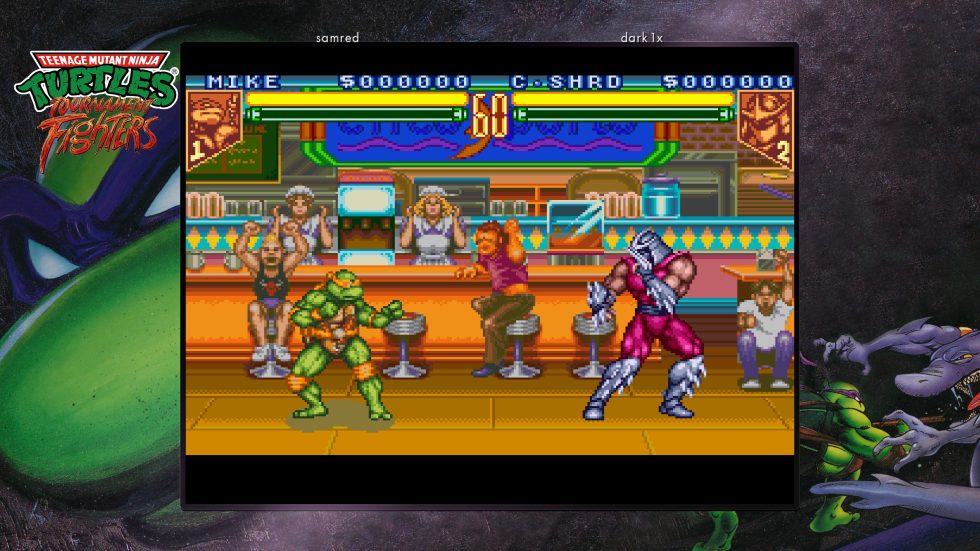
Thanks to a GGPO-powered rollback netcode model, the collection’s online modes do a great job contending with your turtle pals’ actions. While testing with Digital Foundry mainstay John Linneman from his home in Germany, a full nine time zones away, I noticed only the faintest hiccups in terms of any character refreshing after a false frame of animation or two. The action felt smoothest in the wholly 2D combat of Tournament Fighters; it honestly felt like we were in the same room. The more dynamic stuff of the other online-supported games had a slightly floaty feel, like they were being played on an older LCD panel. Not bad for a less-than-ideal latency environment.
Ahead of the game’s retail launch on multiple consoles and PC, we couldn’t conduct wider tests of the games’ public matchmaking options. Only four of the collection’s 10 multiplayer-enabled games support online play: TMNT Tournament Fighters (SNES edition), TMNT Hyperstone Heist (Genesis), and both original arcade games. Perhaps this limitation was meant to reduce matchmaking wait times, as each of the games can be played with either friends or online strangers. Still, I would have liked “friends-only” online options for the other games, so that I might relive my early ’90s days of kicking some NES shell with best friends (particularly the NES-only TMNT 3, which has unique levels and mechanics).
Sadly, all of the cool and useful toggles in the four supported games’ online modes are removed. No stage select; no invincibility; no selectable boss characters; and players can’t even change display settings beyond the games’ defaults (which include full-screen zooms, screen filters that resemble older panels, and changing or disabling background art).
Additionally, something is amiss in Digital Eclipse’s netcode in terms of audio handling. All four supported games’ online play suffer from significant distortion in music and sound effects—so much, in fact, that I immediately turned down in-game audio, lest I be driven nuts by the constant glitchy sounds. We’ve seen other rollback netcode projects in the retro-gaming space, particularly the community driven Fightcade, figure out audio reproduction of classic games, so we’re not sure what’s up with Digital Eclipse’s audio issues.

